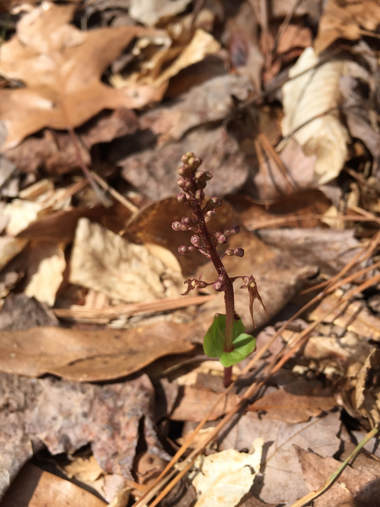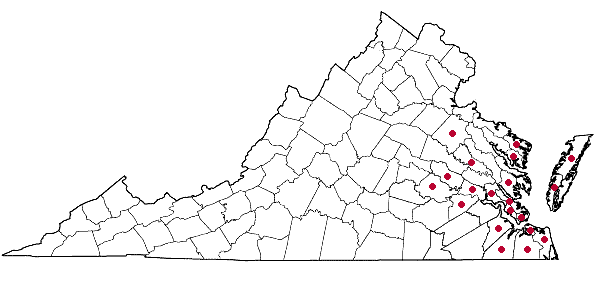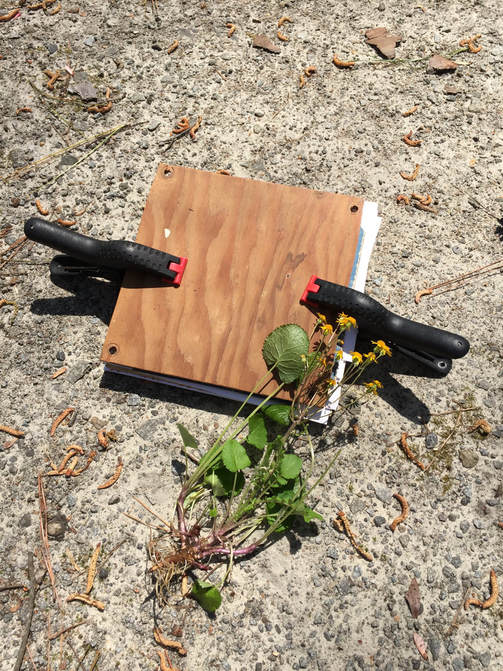 Southern twayblade (Listera australis), a native orchid. Photo by Ashley DeCarme, VMN – Peninsula Chapter
Southern twayblade (Listera australis), a native orchid. Photo by Ashley DeCarme, VMN – Peninsula Chapter
In late March and mid-April of this year, fellow Master Naturalist John Bunch (VMN-Historic Southside Chapter) and I took trips to explore the flora of two privately owned sites in Southampton County. We found populations of the native orchid southern twayblade (Listera australis) and the native forb golden ragwort (Packera aurea), neither of which were currently listed as present in Southampton County, and began the process of creating these two new county records.
Plant species distribution data in Virginia are curated by Virginia Botanical Associates (VBA), the organization that first published an atlas of Virginia’s flora in 1977. As of 2005, distributions for each of Virginia’s plant species (bryophytes included) are accessible through VBA’s Digital Atlas of the Virginia Flora at vaplantatlas.org, or through the Flora of Virginia app, available for iOS and Android. (Maps from either source display the same information, though the website is updated more frequently.) On each species map, a red dot in a county indicates that the species is established (growing and reproducing on its own) in at least one location in the county. A new map is created when a plant is documented in the state for the first time; the majority of recently created maps are for introduced species, but occasionally a new native species is recognized. In the near future, different colored dots will be used to indicate a native occurrence versus an introduced occurrence (a single species may be native to certain counties, and introduced in others).
Contributions to the distribution maps are made by botanists and professionals in related fields, and by volunteers. The process is as follows. First, seek relevant permissions to explore and potentially collect from a site. If a species is found in a location that is not recorded on state distribution maps (or if a species is found that is new to Virginia), consider collecting a specimen or, in the case of a large plant, representative parts. The plant should be in flower or fruit or otherwise absolutely identifiable. Press the specimen between layers of absorbent paper and wood (or similar) until dry, then mail with a label to an herbarium in the region. (A world map of herbaria is available at sweetgum.nybg.org/science/ih or by searching for “Index Herbariorum.”) The label should include such information as the species, the date and location of collection, a location description, and the identity of the collectors. The herbarium can have the species identity verified if necessary. If the plant is rare and/or the population is of an extremely small size, take several high-quality photos in lieu of a specimen and consult an herbarium curator or a botanist with the Virginia Natural Heritage Program. More information can be found at vaplantatlas.org under “Contribute New Records.”
In most cases, a specimen submitted from a new county will remain part of the permanent collection of an herbarium. Species records are never removed from distribution maps, even if the plant has not been observed in the county in decades. Instead, after 25 years, the record is marked “Historic” (state rank: SH) on the Virginia Natural Heritage Program’s list of rare plants (dcr.virginia.gov/natural-heritage/document/plantlist17.pdf). In only one case (Rhynchospora pallida, pale beaksedge) a species has been marked “Extirpated” from the state (state rank: SX), but the original distribution records remain.
As a Virginia Master Naturalist, I frequently use plant distribution records to help identify plants, but I keep in mind that certain records may be missing or in flux. If a distribution map shows a species growing only in counties in the mountainous region of the state, I don’t expect it to find it in Hampton Roads. However, if a county without a record of a plant shares physiogeographic characteristics with a county with a record of the same plant, it wouldn’t be unlikely to find the plant in both counties.
Thanks to Chris Ludwig, Chief Biologist, Natural Heritage Program, and Beth Chambers, Herbarium Curator, College of William and Mary, for information used in this article.


